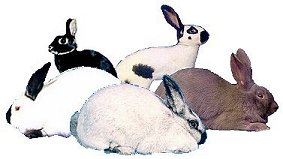The most common problems of the mouth are related to Malocclusions or improper alignment, of the teeth. When the teeth do not meet properly, they do not wear down evenly, and the result is the overgrowth of the teeth.
Malocclusions may begin in the incisor teeth (front teeth), then the molar teeth (back teeth) there are many predisposing factors, including heredity, diet and nutrition, injury to the teeth and infection.
Rabbits have a total of 28 teeth. Most people do not realize that rabbits have teeth other than they incisors (front teeth).
Their teeth are opened-rooted teeth that grow continuously throughout their life. The grinding of the upper and lower teeth against each other is what keeps them from growing too long.
There is no Enamel on the teeth, which lets the teeth wear down more quickly. The nerves do not travel the lenght of the tooth, which prevents any discomfort to the rabbit in the portion of the tooth that is being worn down.
Rabbits have 6 incisor teeth. There are 4 upper and 2 lower incisors. These can be seen by seperating the front lips. The smallest 2 incisors sit behind the first upper incisors. These small incisors are called "peg teeth". When resting the lower incisor teeth sit in the groove between the two sets of upper incisor teeth.
The remaining teeth in the mouth are premolars and molars. They are referred to as the "cheek teeth".
What To Watch For:DroolingGrinding teethDecreased food intakeActing hungry but not eatingSelective appetite for softer foods onlyDiagnosis:Veterinary examination can usually identify incisor malocclusions.
X-Rays of the skull may be necessary to evaluate the tooth roots to evaluate nearby bones for signs of trauma or fractures.
If there is suspicion of infection, cultures will be necessary to identify the cause and choose the best treatment and antibiotics to fight the infection.
Treatment:Treatment for Malocclusion involves trimming (filing or clipping) the teeth.
Your Veterinian will clean the wounds inside the mouth and Antibiotics may be prescribed if infection is suspected.
In severe cases, the incisor teeth can be surgically removed. This is permanent and must be discussed with your Veterinarian.
